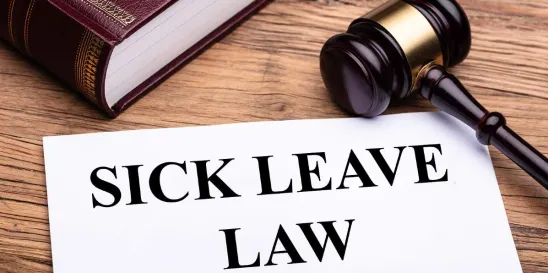On September 15, 2023, the New York City Department of Consumer and Worker Protection (DCWP) issued a final rule (Final Rule) on the city’s Earned Safe and Sick Time Act (ESSTA).
As summarized below, the Final Rule provides some clarification on various compliance issues such as coverage, required notice of usage, supporting documentation that can be requested, the rate of pay for usage, written policy requirements, pay statement requirements and penalties.
Recap of ESSTA
Under the ESSTA, employees may use safe/sick time for various reasons. Depending on the size and net annual income, employers must provide their employees up to 40 hours or 56 hours of paid safe/sick time each year. In particular:
- Employers with at least 100 employees must provide up to 56 hours of paid safe/sick time each year;
- Employers with fewer than 100 employees must provide 40 hours of paid safe/sick time;
- Employers with up to four employees must provide 40 hours of paid safe/sick time if the company had net income of at least $1 million in the previous tax year; and
- Employers with up to four employees with a net income of less than $1 million in the previous tax year must provide 40 hours of unpaid safe/sick time.
Although the employer size is a significant premise in determining the amount of safe/sick time, the law leaves the question of how to calculate the employer size open.
As COVID-19 greatly impacted where employees physically worked, the ESSTA did not address the question of who is a “New York City employee” in light of a large number of employees still working remotely.
Clarification on Employer Count
The Final Rule defines the employer headcount as the highest headcount at any point in a calendar year nationwide.
Note that the headcount includes both full-time and part-time employees. The headcount also includes employees who are jointly employed by more than one employer (all joint employers must count the employee), regardless of whether the employee’s name appears on the employer’s payroll.
If the employer’s headcount grows to over 99 employees, the employer must immediately allow the employees to accrue up to 56 hours of safe/sick time in the same calendar year.
On the flip side, if an employer’s headcount decreases to below 100 employees, it must allow the employees to still accrue up to 56 hours until the next year when the employer can reduce the maximum annual accrual amount to up to 40 hours.
Clarification on New York City Employee Coverage
The Final Rule clarifies that the ESSTA applies to the employees who meet one of the following conditions:
- The employee physically works in New York City, regardless of where the employer is located;
- The employee works remotely but physically works in New York City, regardless of where the employer is located; or
- The employee primarily works outside of New York City but regularly performs, or is expected to regularly perform, work in New York City during a calendar year. Notably, for such an employee, only the hours worked within New York City shall count toward the accrual of safe/sick time under ESSTA.
To help understand the last scenario, here is an example:
A retail business based in New Jersey with locations in both New Jersey and New York City hires a new employee. The employee, who lives in New Jersey, will work primarily at a New Jersey location but may be asked to cover shifts in New York City when needed due to staffing shortages at those locations.
The employer estimates that some months, the employee will work one to three, six- to eight-hour shifts in New York City, but that their New York City hours will vary, and some months, the employee may not work in New York City at all. This is work that the employer expects the employee to perform regularly, so the employee is employed for hire within the City of New York for the purposes of ESSTA. The employee must accrue one hour of safe/sick time for every 30 hours worked within New York City and must be allowed to use their accrued hours when scheduled to work within New York City.
Notice and Supporting Documentation
The Final Rule newly defines “foreseeable absence.” A need is foreseeable when the employee is aware of the need to use safe/sick time seven days or more before such use. Otherwise, the need is not foreseeable.
The Final Rule specifically adds licensed clinical social workers and licensed mental health counselors as providers of signed documents to support the employee’s request for safe/sick leave.
The Final Rule reiterates the limits of what information employers can request. For example, for use of safe time, employers cannot require disclosure of details, except the dates the employee intends to use safe time leave.
Further, if an employee incurs expenses when obtaining the requested supporting documents, the employer must reimburse the expenses.
Rate of Pay
A reminder that the ESSTA requires the employer to pay employees requesting safe/sick time the employee’s base rate of pay at the time of absence provided that the rate of pay is not less than the highest applicable rate of pay pursuant to any applicable federal, state or local law, rule, contract or agreement, including any applicable minimum wage rate. The current New York City minimum wage is $15 an hour and will increase to $16 on January 1, 2024. The employer must pay employees for whom a tip credit is taken the full minimum wage.
Written Policy Requirement
The Final Rule requires employers to add a statement concerning confidentiality to the employer’s policy. Here is the statement provided by the Final Rule:
The employer will not ask the employee to provide details about the medical condition that led the employee to use sick time or the personal situation that led the employee to use safe time, and that any information the employer receives about the employee’s use of safe/sick time will be kept confidential and not disclosed to anyone without the employee’s written permission or as required by law.
Pay Statement Requirements
If the employer uses an electronic system to issue pay statements or other written documents in relation to safe/sick time, the employer may utilize the electronic system to alert the employees and ensure the information regarding safe/sick time is readily accessible to the employee outside of the workplace.
Transfer of Employees
The Final Rule emphasizes that employees’ safe/sick time balances must remain regardless of any business sale, transfers in corporate ownership or changes in subcontracting relationships between corporate entities.
Penalties and Enforcement
The ESSTA imposes fines and a range of penalties for non-compliant employers.
The Final Rule provides that there shall be a “reasonable inference” that the employer violates the ESSTA if it fails to maintain or distribute a written safe/sick time policy and retain adequate records of employees’ safe/sick time use and balance.
Additionally, the Final Rule lists examples of evidence that an employer maintains a policy or practice of not providing or refusing the use of accrued safe/sick time, such as requirements that workers find replacement workers to cover missed shifts due to safe/sick time, unreasonable notice requirements, probation/waiting periods or other measures that prevent employees from using safe/sick time.
The adopted changes in the Final Rule became effective on October 15, 2023. New York City employers should ensure they have taken necessary steps to understand and comply with the contents in the Final Rule.






 />i
/>i
